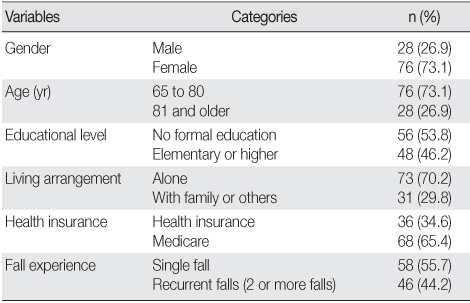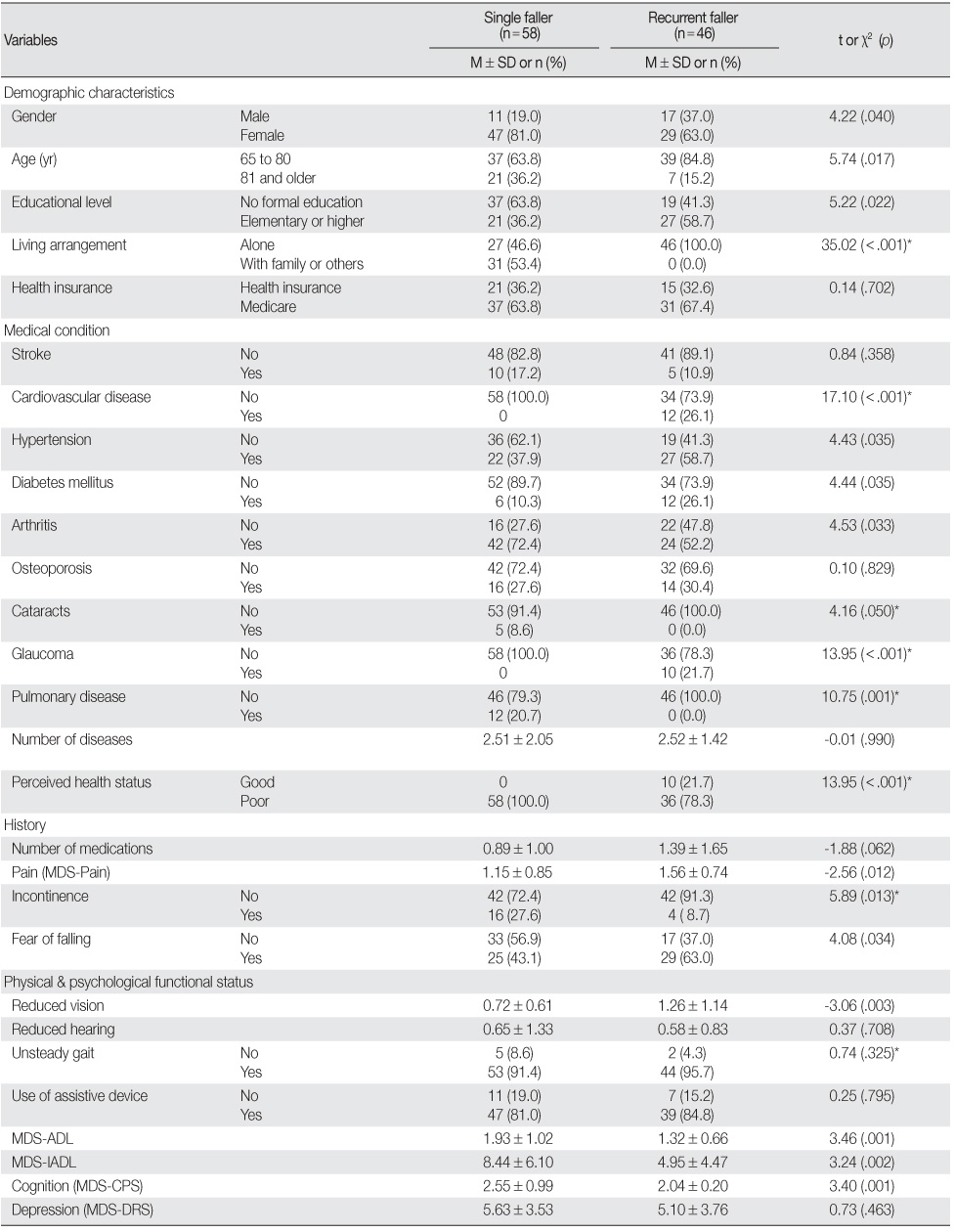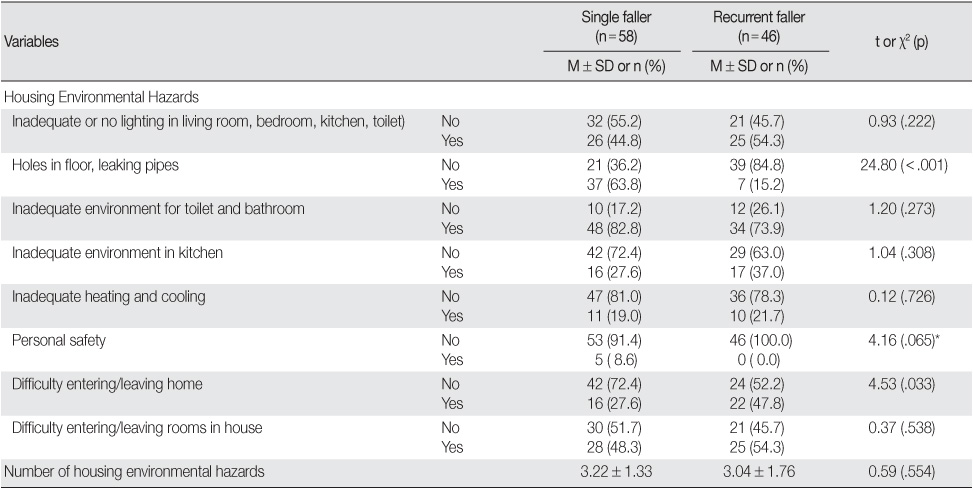Articles
- Page Path
- HOME > J Korean Acad Nurs > Volume 41(1); 2011 > Article
-
Original Article
- Analysis of Multi-variate Recurrent Fall Risk Factors in Elderly People Using Residential Assessment Instrument-Home Care - Comparisons between Single and Recurrent Fallers -
- In-Young Yoo
-
Journal of Korean Academy of Nursing 2011;41(1):119-128.
DOI: https://doi.org/10.4040/jkan.2011.41.1.119
Published online: February 28, 2011
Assistant Professor, Department of Nursing, Jeonju University, Jeonju, Korea.
- Address reprint requests to: Yoo, In-Young. Department of Nursing, Jeonju University, 1200 Hyoja-dong 3-ga Wansan-gu, Jeonju 560-759, Korea. Tel: +82-63-220-2759, Fax: +82-63-220-2054, yiny@jj.ac.kr
© 2011 Korean Society of Nursing Science
Abstract
-
Purpose
- This study was done to determine the risk factors for recurrent fallers (2+falls) compared to single fallers.
-
Methods
- Participants were 104 community-dwelling people 65 yr of age or older. The data were collected from June 1, 2008 to June 30, 2009 using the Residential Assessment Instrument-Home Care.
-
Results
- Over the past 90 days, 55.7% of the 104 participants fell once, and 44.2% experienced recurrent falls (2+falls). In comparison of recurrent fallers with single fallers, there were significant differences in scores on the following factors: gender (χ2=4.22, p=.040), age (χ2=5.74, p=.017), educational level (χ2=5.22, p=.022), living arrangements (χ2=35.02, p<.001), cardiovascular diseases (χ2=17.10, p<.001), hypertension (χ2=4.43, p=.035), diabetes mellitus (χ2=4.44, p=.035), glaucoma (χ2=13.95, p<.001), Minimal Data Set (MDS)-Pain (t=-2.56, p=.012), fear of falling (χ2=4.08, p=.034), reduced vision (t=-3.06, p=.003), MDS-activity of daily living (t=3.46, p=.001), MDS-Instrumental Activities of daily living (t=3.24, p=.002), cognition (MDS-Cognition Performance Scale) (t=3.40, p=.001), and 'difficulties entering and leaving the house' (χ2=4.53, p=.033).
-
Conclusion
- It is important to assess the risk factors for recurrent falls and develop differentiated strategies that will help prevent recurrent falls. Additionally, utilizing a standardized tool, such as RAI-HC, would help health professionals assess multi-variate fall risk factors to facilitate comparisons of different community care settings.
- 1. Blyth R, Cumming P, Mitchell J, Wang JJ. Pain and falls in older people. European Journal of Pain. 2003;11:564–571.Article
- 2. Buatois S, Gueuen R, Gauchard GC, Benetos A, Perrin PP. Posturography and risk of recurrent falls in healthy non-institutionalized persons aged over 65. Gerontology. 2006;52:345–352.ArticlePubMedPDF
- 3. Burrows A, Morris JN, Simon S, Hirdes JP, Phillips C. Development of a minimum data set-based depression rating scale for use in nursing homes. Age and Ageing. 2000;29:165–172.ArticlePubMed
- 4. Chen Y, Hwang S, Chen L, Chen D, Lan C. Risk factors for falls among elderly men in a veterans home. Journal of the Chinese Medical Association. 2008;71(4):180–185.ArticlePubMed
- 5. Choi ES, Lim KI, Jun TW. The study of isokinetic muscle power, flexibility, static balance and dynamic reaction time according to the frequency of fall down in elderly women. Journal of Korean Physical Education Association for Girls and Women. 2007;21(3):55–64.
- 6. Chu LW, Chi I, Chiu AY. Incidence and predictors of falls in the Chinese elderly. Annals of the Academy of Medicine, Singapore. 2005;34(1):60–72.ArticlePubMed
- 7. Cummings SR, Netitt MC, Kidd S. Forgetting falls, the limited accuracy of recall of falls in the elderly. Journal of the American Geriatrics Society. 1988;36:613–616.PubMed
- 8. Fleming J, Mattews FE, Brane C. Cambridge City over-75s Cohort (CC75C) study collaboration.Falls in advanced old age: Recalled falls and prospective follow-up of over-90-year-olds in the Cambridge city over-75s cohort study. BMC Geriatrics. 2008;8:6. ArticlePubMedPMCPDF
- 9. Fletcher PC, Berg K, Dalby DM, Hirdes JP. Risk factors for falling among community-based seniors. Journal of Patient Safety. 2009;5(2):61–66.ArticlePubMed
- 10. Fletcher PC, Hirdes JP. Risk factors for falling among community- based seniors using home care services. The Journals of Gerontology. Series A, Biological Sciences and Medical Sciences. 2002;57:M504–M510.ArticlePubMed
- 11. French DD, Werner DC, Campbell RR, Powell-Cope GM, Nelson AL, Rubenstein LZ, et al. A multivariate fall risk assessment model for VHA nursing homes using the minimum data set. Journal of the American Medical Directors Association. 2007;8:115–122.ArticlePubMed
- 12. Fries BE, Simon SE, Morris JN, Flodstrom C, Bookstein FL. Pain in US nursing homes: Validating a pain scale for the minimum data set. Gerontologist. 2001;41:173–179.PubMed
- 13. Gassmann KG, Rupprecht R, Freiberger E. Predictors for occasional and recurrent falls in community-dwelling older people. Zeitschrift fur Gerontologie und Geriatrie. 2009;42(1):3–10.ArticlePubMedPDF
- 14. Harber D. Health promotion and aging: Practical applications for health professionals. 2004;3rd ed. New York, Springer Publishing Company, Inc.
- 15. Hauer K, Lamb SE, Jorstad EC, Todd C, Becker C. Systematic review of definitions and methods of measuring falls in randomised controlled fall prevention trials. Age and Ageing. 2006;35:5–10.ArticlePubMed
- 16. Kim JM, Lee MS. Risk factors for falls in the elderly population in Korea: An analysis of the third Korea national health and nutrition examination survey data. Journal of Korean Society for Health Education and Promotion. 2007;24(4):23–39.
- 17. Kim JS, Bae SI, Park IS, Gu MK, Hong SW. The analysis of the transition about health care expenditure for the elderly of aging society. 2003;Seoul, National Health Insurance Corporation.
- 18. Kim SM, Bae SS, Kim DH, June KJ, Kim CY, Yoon JL. Validity of resident assessment instrument-minimum data set home care version in Korea. Journal of the Korean Geriatrics Society. 2000;4(1):68–75.
- 19. Lipsitz LA, Jonsson PV, Kelly MM, Koestner JS. Causes and correlates of recurrent falls in ambulatory frail elderly. Journal of Gerontology. 1991;46:M114–M122.ArticlePubMed
- 20. Lord SR, Dayhew J. Visual risk factors for falls in older people. Journal of the American Geriatrics Society. 2001;49:508–515.ArticlePubMed
- 21. Lord S, Sherrington C, Menz H. Falls in older people: Risk factors and strategies for prevention. 2001;Cambridge, Cambridge University Press.
- 22. Cesari M, Landi F, Torre S, Onder G, Lattanzio F, Bernabei R. Prevalence and risk factors for falls in an older community-dwelling population. The Journals of Gerontology. Series A, Biological Sciences and Medical Sciences. 2002;57:M722–M726.ArticlePubMed
- 23. Morris JN, Fries BE, Bernabei R. RAI-home care assessment manual. 1996;Washinton, DC, InterRAI Corporation.
- 24. Morris JN, Fries BE, Mehr DR, Hawes C, Philips C, Mor V, et al. MDS cognitive performance scale. Journal of Gerontology. 1994;49:M174–M182.ArticlePubMed
- 25. Morris JN, Fries BE, Morris SA. Scaling ADLs within the MDS. The Journals of Gerontology. Series A, Biological Sciences and Medical Sciences. 1999;54:M546–M553.ArticlePubMed
- 26. Nikolaus T, Bach M. Preventing falls in community-dwelling frail older people using a home intervention team (HIT): Results from the randomized falls HIT trial. Journal of the American Geriatrics Society. 2003;51:300–305.ArticlePubMed
- 27. Park HS, Chang R, Park KY. Comparative study on fall related characteristics between single and recurrent falls in community-dwelling older women. Journal of Korean Academy of Adult Nursing. 2008;20:905–916.
- 28. Runge JW. The cost of injury. Emergency Medicine Clinics of North America. 1993;11:241–253.ArticlePubMed
- 29. Stephan RL. Visual risk factors for falls in older people. Age and Ageing. 2006;35:Suppl 2. ii42–ii45.ArticlePubMed
- 30. Yoo IY. Fall and housing environmental problem of the couple and single elderly. Journal of the Korean Society of Living Environmental System. 2005;12:199–205.
REFERENCES
Figure & Data
REFERENCES
Citations

- Determining the Health Care Behavior Needs of Older Adults Based on the Omaha System
Nazmiye Kızılkaya, Gulumser Kubilay, Gulten Sucu Dag
Sage Open.2024;[Epub] CrossRef - The geographic environment and the frequency of falling: a study of mortality outcomes in elderly people in China
Yi Huang, Chen Li, Xianjing Lu, Yue Wang
Geospatial Health.2023;[Epub] CrossRef - Environmental Factors Influencing the Prevalence of Falls in South Korea
Beomryong Kim, Kwangsun Do, Jongeun Yim
Physical Therapy Rehabilitation Science.2022; 11(1): 66. CrossRef - The effects of mental health on recurrent falls among elderly adults, based on Korean Community Health Survey data
Kyung Hee Jo, Jong Park, So Yeon Ryu
Epidemiology and Health.2020; 42: e2020005. CrossRef - Fall Risk Classification in Community-Dwelling Older Adults Using a Smart Wrist-Worn Device and the Resident Assessment Instrument-Home Care: Prospective Observational Study
Yang Yang, John P Hirdes, Joel A Dubin, Joon Lee
JMIR Aging.2019; 2(1): e12153. CrossRef - Risk factors of repeated falls in the community dwelling old people
Jae Soon Yoo, Chul Gyu Kim, Jong Eun Yim, Mi Yang Jeon
Journal of Exercise Rehabilitation.2019; 15(2): 275. CrossRef - Zero-Inflated Poisson Modeling of Fall Risk Factors in Community-Dwelling Older Adults
Dukyoo Jung, Younhee Kang, Mi Young Kim, Rye-Won Ma, Pratibha Bhandari
Western Journal of Nursing Research.2016; 38(2): 231. CrossRef - The Comparison of Risk Factors for Falls in the Community-Dwelling Elderly
Soo-Min Kim
Journal of the Korean Proprioceptive Neuromuscular Facilitation Association.2016; 14(2): 93. CrossRef - Fall Risk in the Community-dwelling Elderly who Received Home Care Services: Focused on Residential Environment and Perception of Fall Risk
Chong Mi Lee, Bok-Hee Cho
Journal of muscle and joint health.2014; 21(1): 36. CrossRef - Effects of a Randomized Controlled Recurrent Fall Prevention Program on Risk Factors for Falls in Frail Elderly Living at Home in Rural Communities
JongEun Yim
Medical Science Monitor.2014; 20: 2283. CrossRef - RAI-HC as an innovative tool for future practice in home care
Helena Kisvetrová, Yukari Yamada
Journal of Nursing, Social Studies, Public Health and Rehabilitation.2014; 5(1-2): 16. CrossRef - Risk Factors for Recurrent Falls Among Community-dwelling Elderly in Rural Areas
Mi-Yang Jeon, Sun Hee Yang
Journal of the Korea Academia-Industrial cooperation Society.2013; 14(12): 6353. CrossRef - Home environmental and health‐related factors among home fallers and recurrent fallers in community dwelling older Korean women
Young Mi Lim, Mi Hae Sung
International Journal of Nursing Practice.2012; 18(5): 481. CrossRef - Fall Prediction Model for Community-dwelling Elders based on Gender
Eun Suk Yun
Journal of Korean Academy of Nursing.2012; 42(6): 810. CrossRef - Telemonitoring System of Fall Detection for the Elderly
Yong-Gyu Lee, Dae-Jin Cheon, Gil-Won Yoon
Journal of Sensor Science and Technology.2011; 20(6): 420. CrossRef
Demographic Characteristics of Participants (N=104)
Differences in Intrinsic Factors between Single and Recurrent Fallers (N=104)
*Fisher's exact test. MDS-ADL=Minimum Data Set-Activities of Daily Living; MDS-IADL=Minimum Data Set-Instrumental Activities of Daily Living; MDS-CPS=Minimum Data Set-Cognitive Performance Scale; MDS-DRS=Minimum Data Set-Depression Rating Scale.
Differences in Extrinsic Factors between Single and Recurrent Fallers (N=104)
*Fisher's exact test.
*Fisher's exact test. MDS-ADL=Minimum Data Set-Activities of Daily Living; MDS-IADL=Minimum Data Set-Instrumental Activities of Daily Living; MDS-CPS=Minimum Data Set-Cognitive Performance Scale; MDS-DRS=Minimum Data Set-Depression Rating Scale.
*Fisher's exact test.
 KSNS
KSNS
 E-SUBMISSION
E-SUBMISSION



 Cite
Cite

